Abstract
It has been more than a decade since the introduction of the Industry 4.0 paradigm. Since then, many issues have been raised in the world: the COVID-19 pandemic, sustainable development goals, and recent dramatic changes in global politics. The global value chains were broken during the pandemic, and the importance of humans as the most important element of the production system was highlighted. It caused rethinking about current industrial paradigms, including the brand new paradigm of Industry 4.0. More focus has been put on human workers, sustainability, and the resilience of the value chain, so the Industry 4.0 update was presented as Industry 5.0. A specific methodology to evaluate the maturity level of the manufacturing industry with regard to Industry 4.0/5.0 is presented and tested in the Croatian manufacturing industry. The developed methodology is unique since it puts Industry 5.0 in the right context with Industry 4.0. Therefore, the Industry 4.0 index remains the main indicator; however, alignment with three Industry 5.0 aims (human-centricity, sustainability, and resilience) represents three additional indicators. The results of the current state analysis are presented as a case study with a discussion about the results and methodology itself.
1. Introduction
Since 2011, Industry 4.0 (I4.0), as a new industrial paradigm, has become a northern star for manufacturing enterprises all over the world [1]. It became a main part of national industrial strategies [2], for instance, “Industrie 4.0” in Germany [3] and “Industria 4.0” in Italy [4]. The focus of Industry 4.0 is to implement advanced information and communication technologies (ICTs), which are the drivers of the fourth industrial revolution, in the manufacturing environment. The advancement of ICT infrastructure enabled the World Wide Web (internet), which enabled connectivity and communication with different kinds of devices, the so-called Internet of Things (IoT). By using IoT sensors and actuators, the manufacturing process can be completely monitored: products can be tracked and traced using radio frequency identification (RFID) technology [5], machine status and electricity or compressed air consumption can be monitored [6,7], stock levels in inventories can be precisely evaluated, errors and defects can be detected, and all of these data can be presented on interactive dashboards.
The result is the cyber–physical system [3,8]: in this case, the cyber–physical production system, which is the actual digital twin of the real-world manufacturing process. The digital twin allows monitoring of the manufacturing process, but it goes beyond monitoring. It can be used to optimize the manufacturing process, simulate the changes, and then implement them in the real world. However, there is a technical and organizational preposition [9] for the complete cyber–physical production system: vertical integration of production. It represents the connection of the enterprise resource planning (ERP) system with the shop-floor level with the help of the manufacturing execution system (MES) through sensors/actuators, thus creating the concept of the Smart Factory [10]. This kind of full control and full insight into production allows the manufacturing of single-item products, so-called personalized [11,12] or individualized production [13]. Furthermore, the cyber–physical production system is not limited to a single manufacturing system. Nevertheless, it can be extended to suppliers, the supply chain, or the whole production network [14].
It is clear that Industry 4.0, as a new industrial paradigm, requires a paradigm shift in enterprises’ business models, organization, and technology. Some serious steps towards Industry 4.0 must be taken. To know what steps to take, an enterprise must know where it is now with regard to Industry 4.0. Therefore, models to evaluate the maturity level of an enterprise with regard to Industry 4.0 or with regard to the adoption of digital technologies have been developing since 2011 [15,16]. Different kinds of models with the same aim of assessing the industrial maturity level of enterprises have been developed in countries all over the world, including Bulgar [17], China [18], Czech [19], Croatia [20,21], Hungary [22], India [23], Indonesia [24], Italy [25], Kazakhstan [26], Kosovo [27], Romania [28], Serbia [22], Slovakia [22], and Turkey [28].
However, there were also critics of Industry 4.0 from the very beginning. The main criticism was the issue of human workers, which was not mentioned much in Industry 4.0 documents. Some saw Industry 4.0 as a political plan to completely replace human workers with robots and machines, but that is not true [29]. Industry 4.0 is actually dealing with a lack of factory workers in developed countries. Nevertheless, the original German document “Industrie 4.0” [3] talks about sustainability, but it does not mention children or future generations [30]. It was something that the European Commission saw as an important issue for this new industrial paradigm.
Then, 2020 came, and the global COVID-19 pandemic struck the EU and the whole world [31]. The importance of a human was highlighted in every aspect. Much of the focus was put on factory workers and every other employee. Furthermore, the pandemic broke global value chains, and the EU was left without some important products like toilet paper and medical masks. The European manufacturing industry was not struggling just because of the pandemic but because of broken supply chains as well. They did not prove to be resilient. All of these aspects were noticed by the European Commission, which published a completely new document in 2021 [32,33], Industry 5.0 (I5.0), which focuses on human-centricity, resilience, and sustainability (Figure 1).
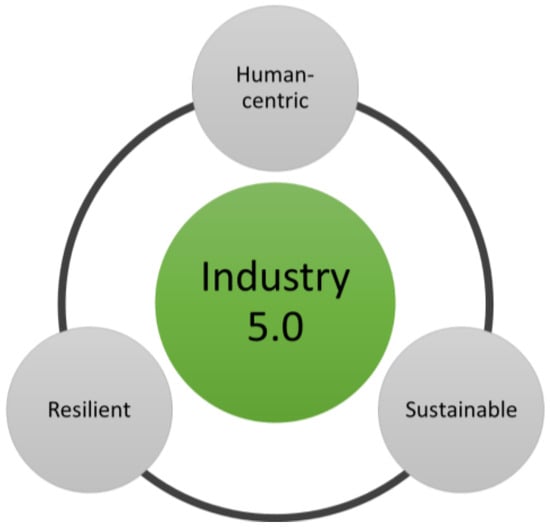
Figure 1.
The European concept of Industry 5.0: human-centricity, resilience, and sustainability.
The focus on human-centricity has another important aspect: the usage of artificial intelligence (AI) and machine learning (ML) in the manufacturing sector that was made popular by Industry 4.0. The problem of AI/ML is they are, most of the time, the black-box solutions that provide some results without clear insight into the process and its parameters. Sometimes, human workers are even subordinated to some AI-based information system, and that fact represents an epochal change. Namely, throughout history, technology was always subordinated to humans, never vice versa. So, putting humans back in the center and having transparent and fair AI/ML technology [34] is one of the most important aspects of Industry 5.0.
But, what, actually, is Industry 5.0? In this research, Industry 5.0 is seen as the European Commission sees it [35]: it is not a replacement for Industry 4.0, but more its update. This kind of view on Industry 5.0 is accepted by other scientists [1], as well. It is important to note that the working paper of the European Commission on the Industry 4.0 update in 2020 was originally called Industry 4.1 [32]. Therefore, the new trends among scientists and practitioners that are already talking about Industry 6.0 [36] are missing the point. It would not be a surprise to see some Industry 7.0 ideas in 2024. But, an industrial paradigm is not an operating system, nor software, so a completely new version cannot be expected each year. At least two or three decades should pass before a new industrial paradigm is presented. Therefore, to conclude, Industry 5.0 is a correction of the aims of Industry 4.0 to fit into the European Green Deal and sustainable global development (Table 1).

Table 1.
The main differences between Industry 4.0 and Industry 5.0 (adapted from [35,37]).
Since Industry 5.0 is a parallel approach to Industry 4.0 (Figure 2), it cannot be something that is replacing it [1]. It also means that when measuring industrial maturity level, Industry 5.0 cannot be a level above Industry 4.0; the assessment is more a measure of how enterprise is aligned with the aims of Industry 5.0: human-centricity, resilience and sustainability.
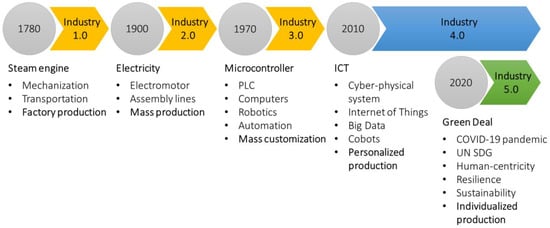
Figure 2.
Industry 4.0 vs. Industry 5.0: comparison and historical overview.
Figure 2 reveals why Industry 5.0 is not a new industrial revolution, because some new technological breakthrough invention did not happen. The first industrial revolution was triggered by the invention of the steam engine, the second by the invention of electricity, the third by the invention of the microcontroller, and the fourth by the development of ICT and invention of the internet; there is no technological invention, at the moment, that could trigger the fifth industrial revolution. Nevertheless, Industry 5.0 was triggered by the EU’s Green Deal, the COVID-19 pandemic and the UN Sustainable Development Goals (SDG)!
It is also important to note that factory production started with mechanization (the steam engine), and with assembly/production lines, it soon became mass production. Later, with the help of computers and information systems, it was possible to introduce mixed-model assembly that allowed mass customization. The modern era, however, is allowing personalized or individualized production [38]. Sometimes personalized and individualized production are seen as the same thing, but sometimes they differ. Personalized production can be seen as the small batch production of personalized products mostly in business-to-business relationships [12], and individualized production can be seen as single-item production in business-to-consumer relationships [13]. Personalized and/or individualized production are not simple aims; therefore, an enterprise should make an effort in acquiring Industry 4.0 technologies to achieve them.
Regarding the evaluation of industrial maturity level, enterprises still should be evaluated with regard to Industry 4.0 aspects. However, an enterprise also should be additionally evaluated in terms of how it is aligned with Industry 5.0 aims—human-centricity, resilience and sustainability. This perspective was implemented into the methodology of this research, which is described in Section 2. The case study used to test the methodology is Croatian manufacturing industry with a focus on manufacturing products made of metal, wood and polymers. The enterprises’ data used in the analysis were collected by using an on-line questionnaire in May 2022, a year after the publication of Industry 5.0 documents by the EC. The results of this analysis are presented in Section 3, and later they are compared with a previous analysis from 2015 [20] in Section 4. At the end, ideas for the further research are discussed.
2. Materials and Methods
In May 2022, an on-line questionnaire, “Croatian manufacturing industry in regard to Industry 4.0/5.0 concept”, was sent to Croatian industrial enterprises in the manufacturing sectors related to products made of metal, wood and polymers. Other sectors—the food and beverage industry, pharmaceutical industry, and mineral processing industry—were deliberately avoided, because these sectors have had a high degree of automation in their manufacturing systems for decades that would affect the results in a way that made technological progress, especially regarding automation and robotics, look much better than it really is.
The data were collected for 2 weeks, and 63 enterprises responded. A similar questionnaire survey regarding Industry 4.0 was conducted in 2015. At that time, 155 enterprises responded, but the data were collected for 3 months. The 2022 survey, however, was a 2-week research undertaking.
The sample of enterprises had very good geographic distribution. The Republic of Croatia is divided into four statistical regions by the EU NUTS-2 division. The sample of industrial enterprises was composed as follows: 25% were enterprises from Adriatic Croatia, 22% from Pannonian Croatia, 40% from Northern Croatia, and 13% from the City of Zagreb (Figure 3). When looking at the geographic map of these regions, the distribution does not seem to be representative. However, the distribution of the whole manufacturing industry must be taken into account. It is true that Adriatic and Pannonian Croatia cover more than 70% of the area of Croatia and only 47% of enterprises in the sample are from these regions, but, similarly to Italy, most of the Croatian manufacturing industry is concentrated in Northern Croatia and the City of Zagreb. Adriatic Croatia is more dedicated to tourism, and Pannonian Croatia is more dedicated to agriculture and ICT.
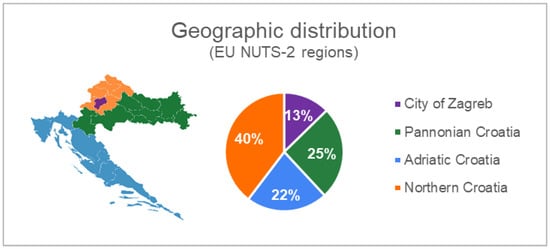
Figure 3.
The geographic distribution of the sample of industrial enterprises.
The sample of enterprises also reflected the distribution of manufacturing sectors well. The manufacturing sectors are divided by product type according to Croatia’s NKD2007 classification. The product types from C17 to C21 and including C23 represent food and beverages, pharmaceuticals, and the mineral processing industry, which were not part of this analysis. The sample represented about 4% of total enterprises in these manufacturing sectors. A comparison of the distribution of enterprises in the sample and of the total population of enterprises is presented in Figure 4. The only difference is that in the entire population, somewhat larger shares of enterprises are engaged in ICT manufacturing and furniture manufacturing, but everything else is quite similar.

Figure 4.
The distribution of enterprises by product type: (a) Sample of enterprises; (b) entire population of enterprises.
The next step was to validate the sample regarding the business size of the enterprises. This criterion also showed that the sample of enterprises was very good (Figure 5). A larger share of large and medium-sized enterprises were in the sample, whereas in reality, the number of microenterprises is higher. However, the ratio of large enterprises and small and medium-sized enterprises (SMEs) was very similar.

Figure 5.
The distribution of enterprises by business size: (a) Sample of enterprises; (b) entire population of enterprises.
Another interesting piece of information was the distribution of enterprises by production volume (Figure 6). Only 26% of the enterprises from the sample were engaged in large-batch production; all others were focused in individualized, small-batch production or individualized/small-batch modular production. However, since the enterprises from the sample were in manufacturing sectors related to products made of metal, wood and polymers, it is important to point out that large-batch production in these sectors in Croatia represented only a minority. Most of the Croatian manufacturing enterprises from these sectors are making products for already-known customers. However, they are more often in business-to-business relationships than business-to-consumer relationships.
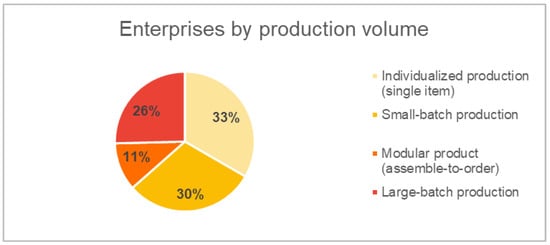
Figure 6.
The distribution of enterprises by production volume.
Regarding the methodology, an on-line questionnaire must cover all important aspects of an enterprise’s technology, organization and employees. It is always a challenge to design such a questionnaire, since the number and details of questions can present a problem. If too many questions are asked and too many details sought, the questionnaire will be time-consuming, and only a small number of queried enterprises will be willing to respond to it. On the other hand, if the number of questions is too low, it will be difficult to obtain a complete picture of the enterprise’s technology, organization and employees. In this research, based on the experience with a previous questionnaire in 2015, a questionnaire was designed to cover the following dimensions (Figure 7): product development, manufacturing technology, work order management, product traceability, inventory/supply chain management, product lifecycle management, quality management, agile and lean principles, environmental health and safety. Similar dimensions were covered in analyses by Veza et al. [20] and by Horvat et al. [26].
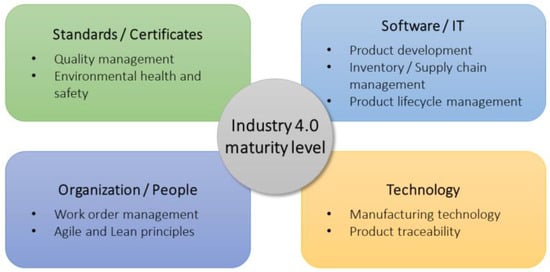
Figure 7.
Enterprise dimensions covered by the questionnaire.
The next important thing was the scoring model, i.e., how the answers to questions were evaluated with regard to Industry 4.0. In this research, we used the same scoring model as in the previous questionnaire from 2015 [20]. In that model, each option (answer) in a question correlated with some industrial generation, i.e., with one of the four industrial revolutions, or it was between two industrial generations. Multiple options could be selected as answers, and the scoring of such questions was an average value of the selected options (Figure 8). This approach was used to evaluate the industrial maturity level of an enterprise in correlation with Industry 4.0.
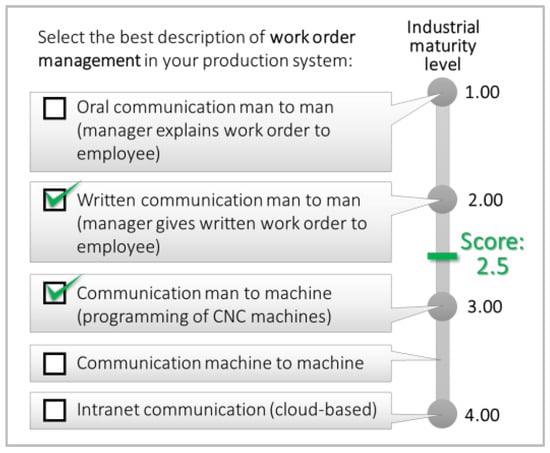
Figure 8.
An example of scoring model for industrial maturity level with regard to Industry 4.0 (adapted from [20]).
Regarding Industry 5.0, a similar scoring approach could be used, but with different outcome. The outcome, i.e., the result, was on a scale not from 1.0 to 4.0, but from 0% to 100%. Nevertheless, we measured three different criteria that represented Industry 5.0 aims: human-centricity, resilience, and sustainability. Some questions concerned only one criterion, and some concerned two or all three criteria. An example of such a scoring is presented in Figure 9.
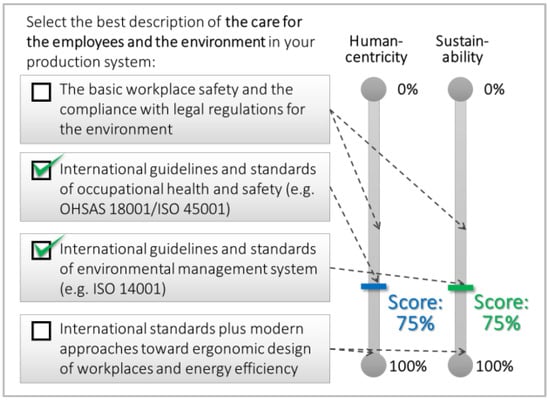
Figure 9.
An example of scoring model for human-centricity and sustainability with regard to Industry 5.0.
The overall industrial maturity level or I4.0 index for an enterprise was an average of the scores for all questions. In the same way, overall I5.0 aims were average values for all of the questions. This meant that the maximum score was 4.00 for the I4.0 index and 100% for each I5.0 aim (human-centricity, resilience and sustainability). An enterprise with such a score would be an ideal Industry 4.0/5.0 enterprise (Figure 10).
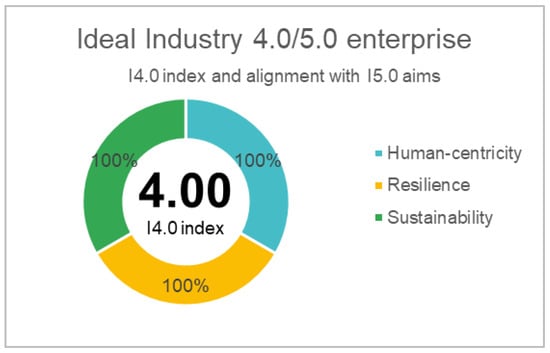
Figure 10.
An example of indicators for ideal Industry 4.0/5.0 enterprise.
The methodology used in this research was not ideal; however, it represented a good balance between the simplicity of the questionnaire design and the complexity of represented issues. As mentioned, if the questionnaire were too long and detailed, only a few people would be willing to respond to it, thus resulting in a poor sample of enterprises. In this case, the questionnaire resulted in a representative sample; therefore, a complete analysis could be made, and the results presented.
3. Results
The presentation of the results of the current state analysis of Croatian manufacturing industry has two parts. The first part is a presentation of the overall indicators for the Croatian manufacturing industry. The second part is a presentation of “the best” enterprise from each of the four statistical regions of Croatia. These four enterprises are then mutually compared.
Figure 11 shows the distribution of enterprises according to industrial maturity level, with 2.45 as the average industrial maturity level (I4.0 index) of the Croatian manufacturing industry. The figure also shows that most of the enterprises still belong to Industry 2.0, but some of them took serious steps toward Industry 3.0. Only few enterprises in the sample, and only a few dozens enterprises in the whole population, belong to Industry 3.0, and they are moving toward Industry 4.0.
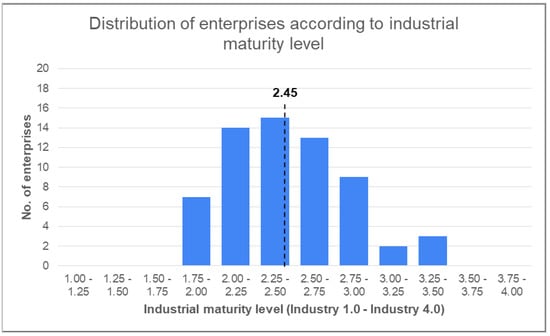
Figure 11.
Distribution of enterprises according to industrial maturity level.
Regarding Industry 5.0, i.e. progress in achieving I5.0 aims, the results of analysis are presented in Figure 12. The average Croatian manufacturing enterprise had an I4.0 index of 2.45, and it achieved 36% of progress regarding the I5.0 aim of human-centricity, 54% of progress regarding the I5.0 aim of resilience, and 50% of progress regarding the I5.0 aim of sustainability. It is important to note that resilience in Croatian manufacturing enterprises is high because most of them are SMEs that do not have global supply chains and Croatia is geographically and demographically a small country with low disturbances in the market. So, perhaps they are not as resilient as they appear to be. On the other hand, the index for human-centricity was low, because the average employee had less than 5 days of training per year.
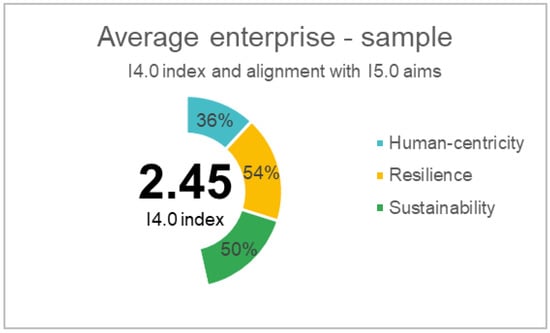
Figure 12.
Average enterprise in Croatian manufacturing industry—I4.0 index and alignment with I5.0 aims.
The next step was to compare “the best” enterprise from each of the four statistical regions of Croatia. Their identity was hidden, but the main information and description of Industry 4.0 and Industry 5.0 elements are presented in Table 2. In the overall I4.0 index ranking, these enterprises were ranked as follows: 1st “The best of” City of Zagreb, 2nd “The best of” Adriatic Croatia, 3rd “The best of” Northern Croatia, and 5th “The best of” Pannonian Croatia. The 4th-ranked enterprise is also from Northern Croatia, so it is not a part of this comparison.

Table 2.
Comparison of “the best” enterprises from each of the four NUTS-2 statistical regions of Croatia.
Figure 13 shows the I4.0 index and alignment with I5.0 aims for all four enterprises, with the I4.0 index ranging from 3.11 to 3.37. It means that all of these enterprises belong to Industry 3.0, and they are on the way toward Industry 4.0.
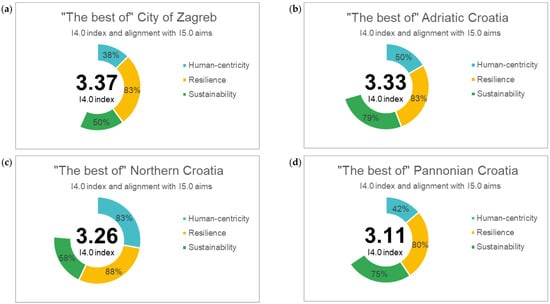
Figure 13.
Enterprise I4.0 index and alignment with I5.0 aims: (a) “The best of” City of Zagreb; (b) “The best of” Adriatic Croatia; (c) “The best of” Northern Croatia; (d) “The best of” Pannonian Croatia.
Regarding I5.0 aims, all four enterprises had similar resilience, of above 80%. But, as mentioned, it was only because they are not so dependent on global supply chains. The sustainability scores were high in “The best of” Adriatic Croatia and “The best of” Pannonian Croatia because both had good product lifecycle management and used environmental management standard ISO 14001. The other two had lower sustainability, because “The best of” City of Zagreb was lacking in product lifecycle management, and “The best of” Northern Croatia was lacking in environmental management. Three out of four enterprises had low progress in human-centricity, because they lacked compliance with occupational health and safety standards such as OHSAS 18001/ISO 45001 and their employees had less than 15 days of training per year. On the other hand, “The best of” Northern Croatia had these standards and was investing in life-long learning programs for its employees.
Figure 14 shows a comparison of the four groups of enterprise dimensions—software/IT, technology, organization/people, and standards/certificates—for these four enterprises.
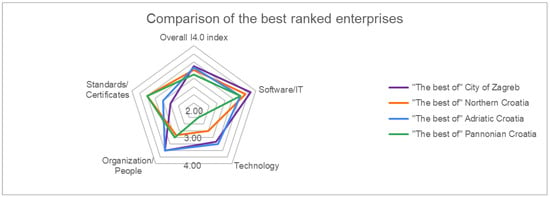
Figure 14.
Comparison of four groups of enterprise dimensions of the “the best” enterprises from each of four NUTS-2 statistical regions of Croatia.
Enterprises “The best of” City of Zagreb and “The best of” Adriatic Croatia were technologically the most advanced, using state-of-the-art machines, including collaborative robots. “The best of” Pannonian Croatia had the worst technology, and it was on an Industry 2.25 level. But it is a large enterprise, and the other three enterprises are SMEs, which proves once again that SMEs tend to adopt new technologies much more easily. On the other hand, the technologically less advanced “The best of” Northern Croatia and “The best of” Pannonian Croatia adopted many more standards/certificates, which are obviously needed for their business. One more finding that can be pointed out is that while “The best of” Northern Croatia had the highest human-centricity progress, from the aspect of organization/people, it was weak because of its heavy reliance on oral instead of documented or digital communication for work-order management.
In the next section, the results of the analysis are discussed in more detail and compared with the results of the analysis from 2015.
4. Discussion and Conclusions
The Republic of Croatia is perceived as a tourist country. Recently, it became one of the most popular tourist destinations in the world. It was selected as the best European destination in 2023 [39], and it has already been selected as one of the Top 10 destinations in the world for 2024 [40]. But, Croatia is not just a tourist country, since tourism is only one part of the Croatian economy. In 2019, before the COVID-19 pandemic, tourism accounted for a 41% share of Croatian exports and about 20% of Croatian GDP. In the same year, industry accounted for a 49% share of Croatian exports and about 20% of Croatian GDP, and it employed about 25% of the Croatian workforce. As in many other European countries, the manufacturing industry is a cornerstone of the Croatian economy. That fact was especially proven during the COVID-19 pandemic, when tourism did not prove to be resilient. But, at the end of the day, not so many people perceive Croatia as an industrial country.
However, the manufacturing industry is very important to Croatia; therefore, the findings of this research are crucial to understand where the Croatian manufacturing industry is going and what the crucial steps are that the manufacturing industry must take to remain competitive. In particular, a majority of firms in the Croatian manufacturing industry still belong to Industry 2.0 (Figure 10), although some have acquired some things from Industry 3.0 (for instance, CNC machines). However, most other technologies, e.g., robotics and automation, have only been introduced into a few manufacturing enterprises. But technology is not the only problem. Since the 1980s and especially the 1990s, lean management as an organizational and leadership concept has been very popular worldwide. In Croatia, lean management did not become popular at all, but it was acquired by some enterprises in the last 20 years [41]. One of the most successful and famous Croatian enterprises started introducing lean management [42] just a year ago! These issues are becoming a serious gap for the Croatian manufacturing industry. Unfortunately, these findings are supported by the “RB Industry 4.0 Readiness Index” [43] of 1.5 calculated by Roland Berger consultants for Croatia (on a scale from 1 to 5, where 1 represents low readiness and 5 represents high readiness). Furthermore, they have included Croatia among the “Hesitators”, a group of countries that are hesitant to make serious investments in their manufacturing industry despite its status as an important economic sector.
The comparison of the analyses of Croatian manufacturing industries from 2015 and 2022 shows that some progress has been made in the industrial maturity level (Figure 15). The average industrial maturity level of Croatian manufacturing industries was 2.15 in 2015, but had risen to 2.45 by 2022. But more importantly, when looking at the distribution of enterprises, more and more enterprises are closer to Industry 3.0. At the moment, Industry 3.0 seems to be the maximum achievement for the manufacturing enterprises in Croatia, since only a dozen enterprises are above Industry 3.0 and moving toward Industry 4.0.
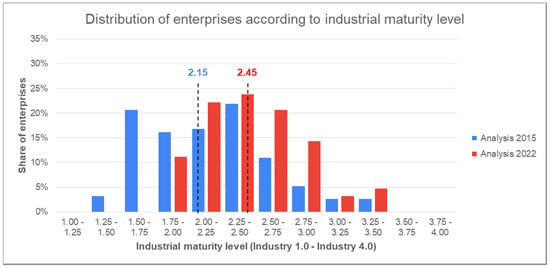
Figure 15.
Comparison of distributions of enterprises according to industrial maturity level from 2015 and 2022.
When analyzing the four groups of enterprise dimensions—software/IT, technology, organization/people, and standards/certificates—an important issue can be discovered. In the case of Croatian manufacturing industry, the comparison of the 2015 and 2022 analyses (Figure 16) shows the most serious issue for Croatian manufacturing enterprises is technology. It remained on almost the same level for 7 years, and that level was just slightly above Industry 2.0. It seems that different kinds of CNC machines remained the top-level technology for most of the enterprises in Croatia. On the other hand, software/IT and standards/certificates showed the strongest improvements because they could all be easily purchased. But, the question is, are they being used properly? Probably not, because there was no similar progress in organization/people, which means that enterprises were purchasing software and certificates, but they were not reaping all the benefits from them. One of the benefits of modern ICT is definitely the usage of the digital twin technology. However, the digital twin was identified in only one of the top five ranked enterprises, and it was a digital twin of inventory only. The digital twin technology can have a serious impact on the improvement of production processes and respective business processes. But, the lack of lean management principles in Croatian manufacturing enterprises also suggests the lack of a process improvement philosophy, thus making a digital twin technology difficult to implement.

Figure 16.
Comparison of four groups of enterprise dimensions and overall I4.0 index from 2015 and 2022.
The current state analysis of the Croatian manufacturing industry in 2022 has provided clear insight into all of the issues and gaps of an average manufacturing enterprise in Croatia. These issues must be considered seriously and addressed in the new industrial strategy of the Republic of Croatia. Since lagging technology is the main issue, a state funding model in combination with EU funds must be established to help Croatian manufacturing enterprises overcome this serious gap. If not, the future of the Croatian manufacturing industry will not be bright at all.
Future research will be focused on the enhancement of the proposed methodology and possible development of a web application for self-assessments by enterprises regarding Industry 4.0/5.0, with a distinctive analysis based on process, product and service-based classifications.
Author Contributions
Conceptualization, M.M. and L.C.; methodology, M.M., L.C., V.M. and I.V.; validation, M.M., L.C., V.M. and I.V.; writing—original draft preparation, M.M., L.C. and V.M.; writing—review and editing, M.M., L.C., V.M. and I.V. All authors have read and agreed to the published version of the manuscript.
Funding
This research received no external funding.
Data Availability Statement
Data are contained within the article.
Acknowledgments
Part of this research was a questionnaire designed for use in research for the Bachelor thesis of Luka Vuletic, under the mentorship of Marko Mladineo.
Conflicts of Interest
The authors declare no conflict of interest.
References
- Xu, X.; Lu, Y.; Vogel-Heuser, B.; Wang, L. Industry 4.0 and Industry 5.0—Inception, conception and perception. J. Manuf. Syst. 2021, 61, 530–535. [Google Scholar] [CrossRef]
- Teixeira, J.E.; Tavares-Lehmann, A.T.C. P Industry 4.0 in the European Union: Policies and national strategies. Technol. Forecast. Soc. Change 2022, 180, 121664. [Google Scholar] [CrossRef]
- Kagermann, H.; Wahlster, W.; Helbig, J. Recommendations for Implementing the Strategic Initiative Industrie 4.0; Heilmeyer und Sernau: Berlin, Germany, 2013. [Google Scholar]
- Klitou, D.; Conrads, J.; Rasmussen, M.; Probst, L.; Pedersen, B. Digital Transformation Monitor Italy: “Industria 4.0”; Publications Office of the European Union: Luxembourg, 2017. [Google Scholar]
- Zhong, R.Y.; Dai, Q.Y.; Qu, T.; Hu, G.J.; Huang, G.Q. RFID-enabled real-time manufacturing execution system for mass-customization production. Robot. Comput.-Integr. Manuf. 2013, 29, 283–292. [Google Scholar] [CrossRef]
- Rocha, A.D.; Freitas, N.; Alemão, D.; Guedes, M.; Martins, R.; Barata, J. Event-Driven Interoperable Manufacturing Ecosystem for Energy Consumption Monitoring. Energies 2021, 14, 3620. [Google Scholar] [CrossRef]
- Celent, L.; Mladineo, M.; Gjeldum, N.; Zizic, M.C. Multi-Criteria Decision Support System for Smart and Sustainable Machining Process. Energies 2022, 15, 772. [Google Scholar] [CrossRef]
- Wang, L.; Wang, G. Big Data in Cyber-Physical Systems, Digital Manufacturing and Industry 4.0. Int. J. Eng. Manuf. 2016, 6, 1–8. [Google Scholar] [CrossRef]
- Crnjac Zizic, M.; Mladineo, M.; Gjeldum, N.; Celent, L. From Industry 4.0 towards Industry 5.0: A Review and Analysis of Paradigm Shift for the People, Organization and Technology. Energies 2022, 15, 5221. [Google Scholar] [CrossRef]
- Zuehlke, D. SmartFactory—Towards a Factory-of-Things. Annu. Rev. Control 2010, 34, 129–138. [Google Scholar] [CrossRef]
- Saniuk, S.; Grabowska, S.; Gajdzik, B. Personalization of Products in the Industry 4.0 Concept and its impact on achieving a Higher Level of Sustainable Consumption. Energies 2020, 13, 5895. [Google Scholar] [CrossRef]
- Mladineo, M.; Crnjac Zizic, M.; Aljinovic, A.; Gjeldum, N. Towards a Knowledge-Based Cognitive System for Industrial Application: Case of Personalized Products. J. Ind. Inf. Integr. 2022, 27, 100284. [Google Scholar] [CrossRef]
- Gu, X.; Koren, Y. Mass-Individualisation—The twenty first century manufacturing paradigm. Int. J. Prod. Res. 2022, 60, 7572–7587. [Google Scholar] [CrossRef]
- Lagorio, A.; Cimini, C.; Pinto, R.; Paris, V. Emergent Virtual Networks amid Emergency: Insights from a Case Study. Int. J. Logist. Res. Appl. 2021, 26, 1124–1144. [Google Scholar] [CrossRef]
- Schumacher, A.; Erol, S.; Sihn, W. A Maturity Model for Assessing Industry 4.0 Readiness and Maturity of Manufacturing Enterprises. Procedia CIRP 2016, 52, 161–166. [Google Scholar] [CrossRef]
- Rauch, E.; Unterhofer, M.; Rojas, R.A.; Gualtieri, L.; Woschank, M.; Matt, D.T. A Maturity Level-Based Assessment Tool to Enhance the Implementation of Industry 4.0 in Small and Medium-Sized Enterprises. Sustainability 2020, 12, 3559. [Google Scholar] [CrossRef]
- Peneva, G.; Andreev, O. Assessing Bulgarian SMEs’ Maturity for Industry 4.0 Implementing—The Case of “Montana Hydraulics” Ltd. Strateg. Policy Sci. Educ. 2023, 31, 9–24. [Google Scholar] [CrossRef]
- Lin, D.; Lee, C.; Lau, H.; Yang, Y. Strategic response to Industry 4.0: An empirical investigation on The Chinese automotive industry. Ind. Manag. Data Syst. 2018, 118, 589–605. [Google Scholar] [CrossRef]
- Vrchota, J.; Pech, M. Readiness of Enterprises in Czech Republic to Implement Industry 4.0: Index of Industry 4.0. Appl. Sci. 2019, 9, 5405. [Google Scholar] [CrossRef]
- Veza, I.; Mladineo, M.; Peko, I. Analysis of the current state of Croatian manufacturing industry with regard to Industry 4.0. In Proceedings of the International Conference CIM 2015, Biograd, Croatia, 10–13 June 2015. [Google Scholar] [CrossRef]
- Peko, I.; Crnjac Zizic, M.; Aljinovic Mestrovic, A.; Gjeldum, N. Application of artificial intelligence fuzzy logic technique in modelling of Industry 4.0 maturity level of production enterprises. In Proceedings of the International Conference Mechanical Technologies and Structural Materials 2023, Split, Croatia, 21–22 September 2023. [Google Scholar]
- Hortovanyi, L.; Morgan, R.E.; Vuksanovic Herceg, I.; Djuricin, D.; Hanak, R.; Horvath, D.; Mocan, M.L.; Romanova, A.; Szabo, R.Z. Assessment of digital maturity: The role of resources and capabilities in digital transformation in B2B firms. Int. J. Prod. Res. 2023, 61, 8043–8061. [Google Scholar] [CrossRef]
- Suresh, N.; Hemamala, K.; Ashok, N. Challenges in implementing industry revolution 4.0 in INDIAN manufacturing SMES: Insights from five case studies. Int. J. Eng. Technol. 2018, 7, 136. [Google Scholar] [CrossRef]
- Tan, H.S.R.; Andhika, A.; Ariyanti, D.; Soebandrija, K. Pengembangan Model Pengukuran Kesiapan Industri 4.0 Untuk Perusahaan Manufaktur di Indonesia. J. PASTI 2019, 13, 106. [Google Scholar] [CrossRef]
- Pirola, F.; Cimini, C.; Pinto, R. Digital readiness assessment of Italian SMEs: A case-study research. J. Manuf. Technol. Manag. 2019, 31, 1045–1083. [Google Scholar] [CrossRef]
- Horvat, D.; Stahlecker, T.; Zenker, A.; Lerch, C.; Mladineo, M. A conceptual approach to analysing manufacturing companies’ profiles concerning Industry 4.0 in emerging economies. Procedia Manuf. 2018, 17, 419–426. [Google Scholar] [CrossRef]
- Azemi, F.; Hajrizi, E.; Maloku, B. Maturity Level of Kosovo Manufacturing Industry with regard to Industry 4. 0. Int. J. Bus. Technol. 2018, 6, 13. [Google Scholar] [CrossRef]
- Demir, S.; Sariisik, G.; Öğütlü, A. KOBİ’lerin Endüstri 4.0 Farkındalık ve Olgunluk Seviyesinin Belirlenmesi: Şanlıurfa İli Örneği. J. Bus. Res.-Turk 2022, 14, 2938–2955. [Google Scholar] [CrossRef]
- Luchtenberg, D. The Fourth Industrial Revolution Will Be People Powered; McKinsey & Company: Chicago, IL, USA, 2022; Available online: https://www.mckinsey.com/capabilities/operations/our-insights/the-fourth-industrial-revolution-will-be-people-powered (accessed on 1 October 2023).
- Mladineo, M. Are the children (again) becoming victims of the Fourth industrial revolution? Res. Prepr. 2023. preprint. [Google Scholar] [CrossRef]
- Javaid, M.; Haleem, A.; Singh, R.P.; Haq, M.I.U.; Raina, A.; Suman, R. Industry 5.0: Potential Applications in COVID-19. J. Ind. Integr. Manag. 2020, 5, 507–530. [Google Scholar] [CrossRef]
- Müller, J. Enabling Technologies for Industry 5.0—Results of a Workshop with Europe’s Technology Leaders; Publications Office of the European Union: Luxembourg, 2020. [Google Scholar]
- Breque, M.; De Nul, L.; Petridis, A. Industry 5.0—Towards a Sustainable, Human-Centric and Resilient European Industry; Publications Office of the European Union: Luxembourg, 2021. [Google Scholar]
- Paglia, V.; Smith, B.; Kelly, J.; Qu, D.; Pisano, P. Rome Call for AI Ethics. Available online: https://www.romecall.org/the-call (accessed on 11 January 2024).
- Renda, A.; Schwaag Serger, S.; Tataj, D.; Morlet, A.; Isaksson, D.; Martins, F.; Mir Roca, M.; Hidalgo, C.; Huang, A.; Dixson-Declève, S.; et al. Industry 5.0, a Transformative Vision for Europe; Publications Office of the European Union: Luxembourg, 2021. [Google Scholar]
- Duggal, A.S.; Malik, P.K.; Gehlot, A.; Singh, R.; Gaba, G.S.; Masud, M.; Al-Amri, J.F. A sequential roadmap to industry 6.0: Exploring future manufacturing trends. IET Commun. 2022, 16, 521–531. [Google Scholar] [CrossRef]
- Celent, L.; Bajić, D.; Jozić, S.; Mladineo, M. Hard Milling Process Based on Compressed Cold Air-Cooling Using Vortex Tube for Sustainable and Smart Manufacturing. Machines 2023, 11, 264. [Google Scholar] [CrossRef]
- Tavares, M.C.; Azevedo, G.; Marques, R.P. The Challenges and Opportunities of Era 5.0 for a More Humanistic and Sustainable Society—A Literature Review. Societies 2022, 12, 149. [Google Scholar] [CrossRef]
- Wanderlust. Wanderlust Reader Travel Award. 2023. Available online: https://www.wanderlust.co.uk/content/wanderlust-reader-travel-awards-results (accessed on 1 December 2023).
- Lonely Planet, Best in Travel 2024—Countries. Available online: https://www.lonelyplanet.com/best-in-travel/countries (accessed on 1 December 2023).
- Prester, J.; Ivanko, F. Rasprostranjenost lean koncepata u hrvatskoj prerađivačkoj industriji. Zb. Ekon. Fak. U Zagreb. 2011, 9, 105–122. [Google Scholar]
- ePodravina.hr, Podravka uvodi Lean Metodologiju za Poboljšanje Poslovanja i Postizanje Prednosti nad Konkurencijom. Available online: https://epodravina.hr/podravka-uvodi-lean-metodologiju-za-poboljsanje-poslovanja-i-postizanje-prednosti-nad-konkurencijom/ (accessed on 1 December 2023).
- Roland Berger, Think Act Magazine: The New Industrial Revolution—How Europe Will Succeed. Available online: https://www.rolandberger.com/publications/publication_pdf/roland_berger_tab_industry_4_0_20140403.pdf (accessed on 11 January 2024).
Disclaimer/Publisher’s Note: The statements, opinions and data contained in all publications are solely those of the individual author(s) and contributor(s) and not of MDPI and/or the editor(s). MDPI and/or the editor(s) disclaim responsibility for any injury to people or property resulting from any ideas, methods, instructions or products referred to in the content. |
© 2024 by the authors. Licensee MDPI, Basel, Switzerland. This article is an open access article distributed under the terms and conditions of the Creative Commons Attribution (CC BY) license (https://creativecommons.org/licenses/by/4.0/).